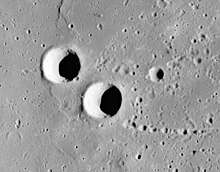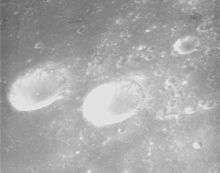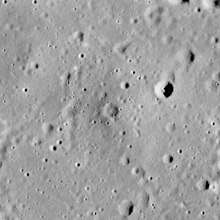Beer (lunar crater)
Beer is a relatively small lunar impact crater located on the Mare Imbrium, to the east of the crater Timocharis. It was named after German astronomer Wilhelm W. Beer.[1] Just to the northwest is the matching twin Feuillée.
 | |
| Coordinates | 27.1°N 9.1°W |
|---|---|
| Diameter | 10 km |
| Depth | 1.7 km |
| Colongitude | 9° at sunrise |
| Eponym | Wilhelm W. Beer |


Beer is a circular, cup-shaped crater with a sharp-edged rim that has not been significantly eroded. The interior has a higher albedo than the surrounding lunar mare, which is usually an indication of a relatively young crater. A string of craters arc away from the rim to the southeast, which then grade into a straight rille, and were once known as Fossa Archimedes or Archimedes Rille, but now are officially unnamed.
The mare to the east has a higher albedo than the surrounding surface, and this lighter-hued surface reaches to the base of the Montes Archimedes. To the southeast of Beer is a lunar dome that is of comparable diameter to the crater.
Satellite craters
By convention these features are identified on lunar maps by placing the letter on the side of the crater midpoint that is closest to Beer.
| Beer | Latitude | Longitude | Diameter |
|---|---|---|---|
| A | 27.2° N | 8.6° W | 4 km |
| B | 25.7° N | 9.0° W | 2 km |
| E | 27.8° N | 7.8° W | 3 km |
External links
- Beer Lunar Topographic Orthophotomap, LTO41A4, May 1974
References
- "Beer (lunar crater)". Gazetteer of Planetary Nomenclature. USGS Astrogeology Research Program.
- Andersson, L. E.; Whitaker, E. A. (1982). NASA Catalogue of Lunar Nomenclature. NASA RP-1097.CS1 maint: ref=harv (link)
- Bussey, B.; Spudis, P. (2004). The Clementine Atlas of the Moon. New York: Cambridge University Press. ISBN 978-0-521-81528-4.CS1 maint: ref=harv (link)
- Cocks, Elijah E.; Cocks, Josiah C. (1995). Who's Who on the Moon: A Biographical Dictionary of Lunar Nomenclature. Tudor Publishers. ISBN 978-0-936389-27-1.CS1 maint: ref=harv (link)
- McDowell, Jonathan (July 15, 2007). "Lunar Nomenclature". Jonathan's Space Report. Retrieved 2007-10-24.CS1 maint: ref=harv (link)
- Menzel, D. H.; Minnaert, M.; Levin, B.; Dollfus, A.; Bell, B. (1971). "Report on Lunar Nomenclature by the Working Group of Commission 17 of the IAU". Space Science Reviews. 12 (2): 136–186. Bibcode:1971SSRv...12..136M. doi:10.1007/BF00171763.CS1 maint: ref=harv (link)
- Moore, Patrick (2001). On the Moon. Sterling Publishing Co. ISBN 978-0-304-35469-6.CS1 maint: ref=harv (link)
- Price, Fred W. (1988). The Moon Observer's Handbook. Cambridge University Press. ISBN 978-0-521-33500-3.CS1 maint: ref=harv (link)
- Rükl, Antonín (1990). Atlas of the Moon. Kalmbach Books. ISBN 978-0-913135-17-4.CS1 maint: ref=harv (link)
- Webb, Rev. T. W. (1962). Celestial Objects for Common Telescopes (6th revised ed.). Dover. ISBN 978-0-486-20917-3.CS1 maint: ref=harv (link)
- Whitaker, Ewen A. (1999). Mapping and Naming the Moon. Cambridge University Press. ISBN 978-0-521-62248-6.CS1 maint: ref=harv (link)
- Wlasuk, Peter T. (2000). Observing the Moon. Springer. ISBN 978-1-85233-193-1.CS1 maint: ref=harv (link)
